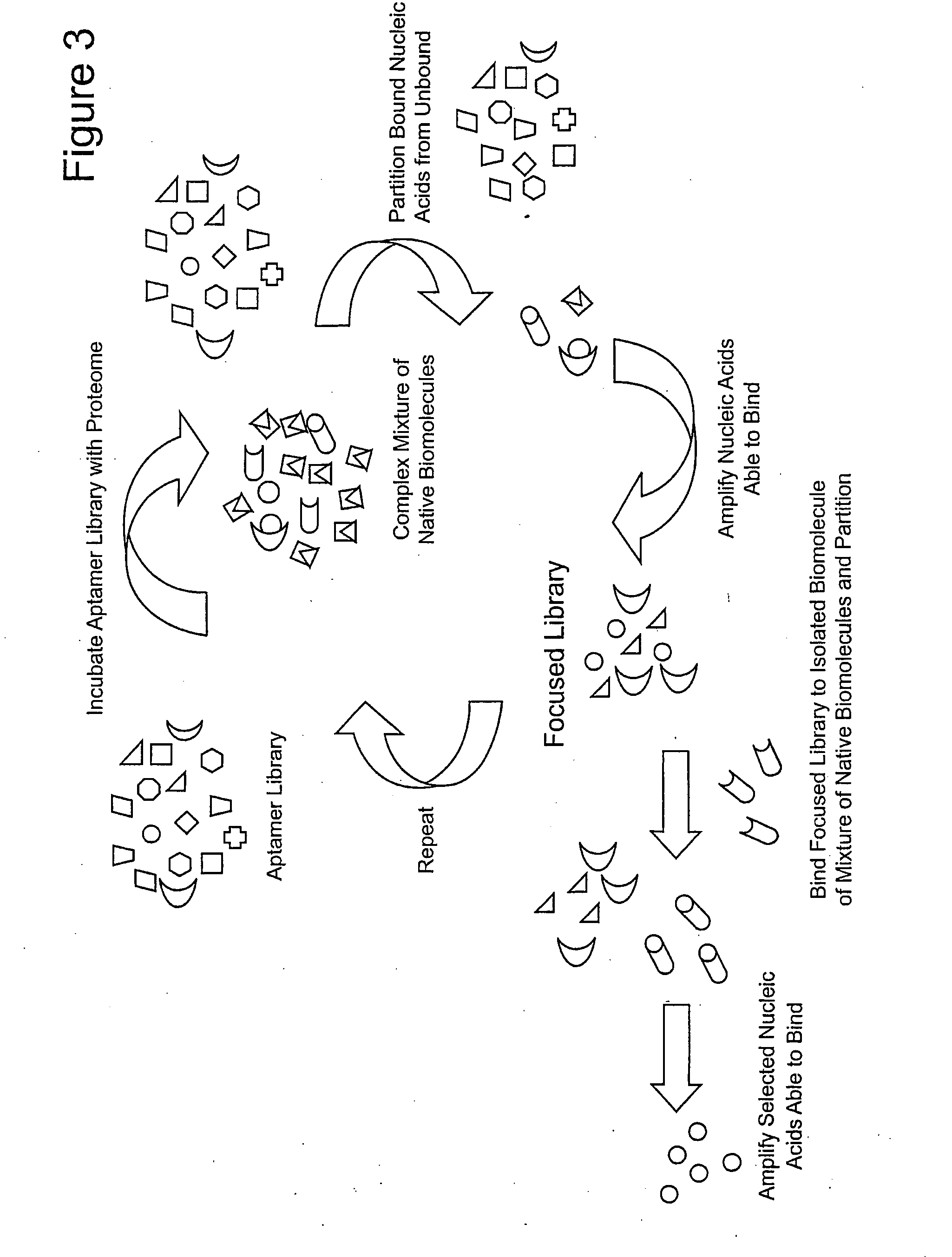Focused Libraries, Functional Profiling, Laser Selex, and Deselex
a functional profiling and focused library technology, applied in the field of focused libraries, functional profiling, laser selex, deselex, can solve the problems of difficult selection of desired nucleic acids, low frequency in the library,
- Summary
- Abstract
- Description
- Claims
- Application Information
AI Technical Summary
Benefits of technology
Problems solved by technology
Method used
Image
Examples
example 1
Focused Library Constructed Against the Platelet Proteome
[0126]Platelets play an important role in hemostasis and the pathogenesis of arterial thrombosis (FIG. 5). When blood vessels are damaged, the small anucleated cell fragments adhere to the exposed subendothelium, are activated, aggregate with one another, and start thrombin generation. Ultimately a platelet plug, which is stabilized by the conversion of fibrinogen to fibrin by thrombin, is formed that stems blood loss at the site of injury. To fulfill their fundamental role in hemostasis, platelets rely on a multitude of surface receptors, as well as other proteins, which are current targets for anti-platelet drug development.
[0127]We constructed a focused library of aptamers against the proteome of purified platelets. Negative selection against a complex mixture of native proteins (i.e., a first proteome) of unstimulated platelets was also performed before positively selecting against a complex mixture of native proteins (i.e...
example 2
Focused Library Constructed Against the Plasma Proteome
[0129]We constructed a focused library of aptamers against the proteome of human plasma. Here, the nucleic acids are modified RNA and the targets are proteins. The aptamers isolated from the focused library are directed against von Willebrand Factor (VWF) and the Fc portion of human immunoglobulin IgG. Over successive rounds, the focused libraries (R5 and R7P) bind proteins of the plasma proteome with greater affinity than an initial pool of RNA aptamers having random sequences (FIG. 12).
example 3
Focused Library Constructed Against GLA-Containing Proteins
[0130]The blood coagulation pathways consists of a series of enzymatic reactions that ultimately results in thrombin converting fibrinogen into a fibrin clot (FIG. 13). A subset of coagulation proteins is the vitamin K-dependent GLA serine protease zymogens, which are characterized by the presence of a gamma-carboxyglutamic acid domain (GLA) at the amino end of the proteins. The GLA proteins are Factor II, Factor VII, Factor IX, Factor X, Protein C, Protein S, and Protein Z. Even though the target proteins are present in the proteome at concentrations that differ by up to 100-fold, aptamers were isolated which bind the different targets.
[0131]By using SELEX against the complex mixture containing GLA proteins, we isolated aptamers to Factor II and Factor X from that focused library (FIG. 14). The aptamers have very high binding affinities and anticoagulate human plasma.
[0132]With any selection of nucleic acids and their ampli...
PUM
| Property | Measurement | Unit |
|---|---|---|
| Fraction | aaaaa | aaaaa |
| Fraction | aaaaa | aaaaa |
| Molar density | aaaaa | aaaaa |
Abstract
Description
Claims
Application Information
 Login to View More
Login to View More - R&D
- Intellectual Property
- Life Sciences
- Materials
- Tech Scout
- Unparalleled Data Quality
- Higher Quality Content
- 60% Fewer Hallucinations
Browse by: Latest US Patents, China's latest patents, Technical Efficacy Thesaurus, Application Domain, Technology Topic, Popular Technical Reports.
© 2025 PatSnap. All rights reserved.Legal|Privacy policy|Modern Slavery Act Transparency Statement|Sitemap|About US| Contact US: help@patsnap.com



